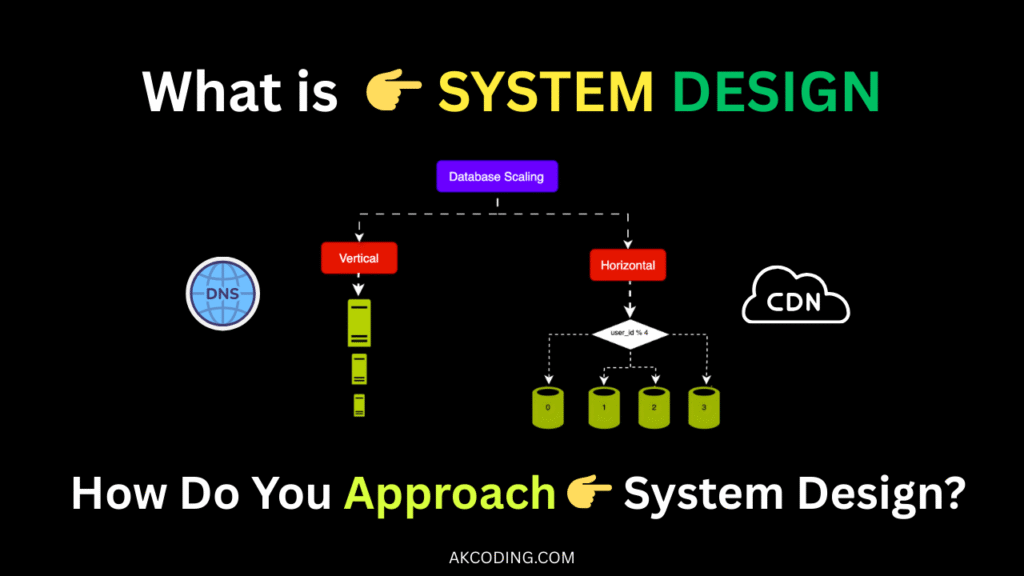Discover what System Design is, why it’s important, and how to approach it. Learn the basics of high-level and low-level design, scalability, and real-world examples like URL shorteners.

Introduction
In today’s digital world, every click, swipe, and search is powered by carefully designed systems. From booking a cab to streaming a movie, millions of users rely on applications that need to be fast, reliable, and scalable. The secret behind making this possible is System Design.
But what exactly is system design, and why is it so important in software engineering? Let’s dive in.
Table of Contents
What is System Design?
System Design is the process of defining the architecture, components, and data flow of a software system. It determines how different parts of an application—like databases, servers, APIs, and user interfaces—work together to solve real-world problems.
In simple terms, if programming is about writing code, system design is about planning how that code will run at scale.
👉 Think of it as city planning:
- Building a small house = writing a simple program.
- Designing a whole city = building a large-scale system like YouTube, Instagram, or Uber.
Why is System Design Important?
Good system design ensures that applications can handle growth, unexpected traffic spikes, and failures. Without it, even the best-written code may crash under load.
Key Benefits of System Design:
- Scalability – The system can grow as users increase.
- Reliability – It stays functional even if some parts fail.
- Performance – Users get fast responses with minimal delay.
- Maintainability – Future developers can add new features without breaking the system.
That’s why system design interviews are a crucial part of hiring at companies like Google, Meta, and Amazon—they want engineers who can think beyond code.
Types of System Design
There are generally two types:
- High-Level Design (HLD):
- Focuses on overall system architecture.
- Defines major components like servers, databases, APIs, and communication flow.
- Example: How Netflix streams videos to millions of users.
- Low-Level Design (LLD):
- Focuses on detailed design of components.
- Includes class diagrams, methods, data structures, and algorithms.
- Example: How a recommendation engine calculates suggestions.
How to Approach a System Design Problem
Whether in an interview or while building real software, you can follow this 5-step framework:
1. Understand the Requirements
- Functional: What does the system need to do?
- Non-Functional: What about scalability, latency, availability?
2. High-Level Architecture
- Draw basic blocks: client, server, database, APIs.
- Show how data flows between them.
3. Choose Database and Storage
- SQL or NoSQL?
- Add caching (Redis, Memcached).
- Use CDN for static files.
4. Add Scalability and Reliability
- Load balancers to distribute traffic.
- Replication and sharding for databases.
- Message queues (Kafka, RabbitMQ) for async processing.
5. Discuss Trade-offs
- No system is perfect.
- Balance between speed, consistency, and cost.
Example: URL Shortener (like Bit.ly)
Let’s take a simple example.
Requirements:
- Convert long URLs into short ones.
- Redirect instantly when a user clicks.
- Handle millions of requests.
Design Approach:
- API for shortening and redirecting.
- Database to store mappings (short → long).
- Cache for faster lookups.
- Load balancer for scaling traffic.
- Background jobs for analytics.
Notice how we never touched actual code—just the architecture. That’s the essence of system design.
Conclusion
System Design is not just about writing efficient code—it’s about thinking at scale. It ensures applications remain fast, reliable, and user-friendly even when millions of people use them.
Whether you’re preparing for interviews or building real-world projects, learning system design will help you think like an architect, not just a coder.
👉 In future guides, we’ll explore system design case studies like WhatsApp, Netflix, and Instagram to see these concepts in action.
Read other awesome articles in Medium.com or in akcoding’s posts.
OR
Join us on YouTube Channel
OR Scan the QR Code to Directly open the Channel 👉

